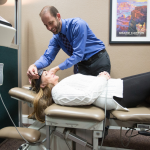Lower Back Pain
Causes of Lower Back Pain
The reasons for lower back pain can be as varied as the people experiencing this unpleasant, yet common condition. Most often it is caused by spinal strain or postural fatigue – up to about 70% of the cases. This is why it can be especially adventitious to regularly check your posture in order to be proactive. Other causes of more immediate lower back pain can be attributed to lifting a heavy object improperly or falling. Lower back pain can also creep in slowly by repeated habits of poor sleeping or stationary posture.
How to Assess and Treat Lower Back Pain
At Northern Nevada Chiropractic, we will go through a 4-stage assessment and treatment plan to give you optimal results toward relief of your lower back pain, and healing to prevent issues in the future.
Step 1: Assess the Source of Pain
At your in-office visit, your chiropractor will assess the symptoms and work to find the root of the pain. Often lower back pain originates in issues with the feet, even if your feet don’t hurt. You feet are your foundation, and if something is a miss there, it can often have adverse effects in the lower back. Your doctor may elect to complete a foot scan using Foot Levelers to see for sure. Your doctor will also look for inflammation or tight muscles, in which case a cold or heat therapy may be applied to relieve the affected area.
Step 2: Treatment to Recover Function
Once we know what is causing the pain, we can work on a treatment plan. This may include regular adjustments, custom-fit functional orthotics, stretching and exercise, hot/cold therapies, and/or massage. Our goal is to regain normal function and rebuild any lost muscle tone that may be a result of “babying” the area while it was in pain.
Step 3: Rehabilitation
The treatment plan will include ways to continue progress even after the lower back begins to feel better. The point of rehabilitation is to get your body to a point where you are at a much lower risk of relapse. Rehab often includes at least quarterly chiropractic visits and expanded at-home exercises and postural retraining.
Step 4: Reinforcement
This is often indicative of lifestyle changes to prevent lower back pain from returning. After doing the work of the treatment plan and rehabilitation, progress often has to be maintained by not slipping back into any old habits. Maybe this is getting an ergonomic desk set-up to keep your posture at work, or a daily walk to get your muscles working, or weekly yoga to maintain flexibility and check in with your body.
If you suffer from lower back pain, even if it is minor, don’t wait to get treatment. Your back and your spine are the core to your health and movement. Protect them, be your advocate for health!




